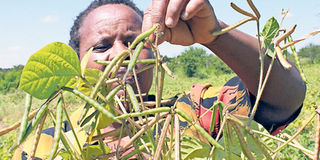To beat erratic rains, grow green grams

Teresia Mutie harvests green grams in her farm. For farmers in arid and semi-arid areas, it is advisable to plant a crop such as mung bean, which is tolerant to water-stress and soil infertility and at the same time takes the shortest time to mature. FILE PHOTO | NATION MEDIA GROUP
What you need to know:
- While the rest of the plants are common, let us demystify mung beans, which are better known as green grams.
- They are a leguminous crop that is able to acclimatise to low soil moisture conditions and survive under water-stress. They are scientifically known as Vigna radiata.
- Mung beans require well-drained, loosely packed soils. This facilitates easy air and water circulation as well as root penetration.
- When more fertiliser is added, the nutrient level might increase to a toxic level that might end up harming the crop, reducing its performance.
If everything remains constant, the new planting season will kick off next month. Thus, many farmers are beginning to prepare for the season by budgeting and doing market research to know what to grow.
This task is much harder for farmers in the drylands since on top of the daily challenges such as soil fertility, they have to grapple with water scarcity.
One, therefore, has to plant crops that can withstand the harsh conditions, among them legumes such as common beans, cowpeas, pigeon peas, dolichos and mung beans.
While the rest of the plants are common, let us demystify mung beans, which are better known as green grams.
They are a leguminous crop that is able to acclimatise to low soil moisture conditions and survive under water-stress. They are scientifically known as Vigna radiata.
They are classified in the same species as cowpeas and both do well in drought conditions as well as in infertile soils.
This is because they are in a position to fix nitrogen hence make their own nutrients for uptake. In the process, mung beans make the soil more fertile than it was before the crop was planted and can be produced either for its grains or as vegetables.
Production
In Kenya, there are various varieties of mung beans that have been developed to adopt to various conditions. KS20 is a variety that appears brownish when dry.
It is commonly known as “Uncle”. Its grains are green in colour and bigger in size. It matures 95 days after planting.
Another variety is the N26. This one is commonly referred to as “Nylon”. Its pods are black when dry and grains appear shiny green when mature. It flowers in 40 days and takes between 60 to 65 days to mature.
MOST PREFERRED VARIETY
This makes it the most preferred variety. These varieties can be obtained from Kenya Agricultural and Livestock Research Organisation, Kenya Seed Company and Simlaw Seeds, among others.
Mung beans require well-drained, loosely packed soils. This facilitates easy air and water circulation as well as root penetration.
The soil should be well-prepared to eliminate large debris and the hard pans that might hinder root penetration and development.
It prefers soils with pH ranges of between 6.0 and 7.4. Planting is done when the temperature is averagely 190C. It is planted at a spacing of 25cm between each hole and 60cm between each row.
The use of fertiliser should be avoided during mung bean production as much as possible, unless the soil is highly eroded and fertility is very low. In this case, the soil must be tested to ascertain how much fertiliser is to be used and for how long.
When more fertiliser is added, the nutrient level might increase to a toxic level that might end up harming the crop, reducing its performance.
In case of eroded soils, application of nitrogenous fertiliser at a lower rate of 10kg Nitrogen/ha is recommended.
During production, mung bean is likely to be attacked by pests such as aphids, beetle and pod sucking bugs, which can be controlled by pesticides while the most common disease is powdery mildew.
Therefore, in the coming planting season, be smarter when deciding the type of crop to grow for maximum benefits.
For farmers in arid and semi-arid areas, plant a crop such as mung bean, which is tolerant to water-stress and soil infertility and at the same time takes the shortest time to mature.
The writer is based at the Department of Crops, Horticulture and Soils, Egerton University.




